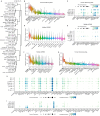Single-cell and spatial transcriptomics analysis of non-small cell lung cancer
- PMID: 38782901
- PMCID: PMC11116453
- DOI: 10.1038/s41467-024-48700-8
Single-cell and spatial transcriptomics analysis of non-small cell lung cancer
Abstract
Lung cancer is the second most frequently diagnosed cancer and the leading cause of cancer-related mortality worldwide. Tumour ecosystems feature diverse immune cell types. Myeloid cells, in particular, are prevalent and have a well-established role in promoting the disease. In our study, we profile approximately 900,000 cells from 25 treatment-naive patients with adenocarcinoma and squamous-cell carcinoma by single-cell and spatial transcriptomics. We note an inverse relationship between anti-inflammatory macrophages and NK cells/T cells, and with reduced NK cell cytotoxicity within the tumour. While we observe a similar cell type composition in both adenocarcinoma and squamous-cell carcinoma, we detect significant differences in the co-expression of various immune checkpoint inhibitors. Moreover, we reveal evidence of a transcriptional "reprogramming" of macrophages in tumours, shifting them towards cholesterol export and adopting a foetal-like transcriptional signature which promotes iron efflux. Our multi-omic resource offers a high-resolution molecular map of tumour-associated macrophages, enhancing our understanding of their role within the tumour microenvironment.
© 2024. The Author(s).
Conflict of interest statement
The authors declare no competing interests.
Figures






References
-
- Sung, H. et al. Global cancer statistics 2020: GLOBOCAN estimates of incidence and mortality worldwide for 36 cancers in 185 countries. CA. Cancer J. Clin. 71, 209–249 (2021). - PubMed
-
- Nicholson AG, et al. The International Association for the Study of Lung Cancer Lung Cancer Staging Project: proposals for the revision of the clinical and pathologic staging of small cell lung cancer in the forthcoming eighth edition of the TNM classification for lung cancer. J. Thorac. Oncol. 2016;11:300–311. doi: 10.1016/j.jtho.2015.10.008. - DOI - PubMed
MeSH terms
Grants and funding
LinkOut - more resources
Full Text Sources
Other Literature Sources
Medical

